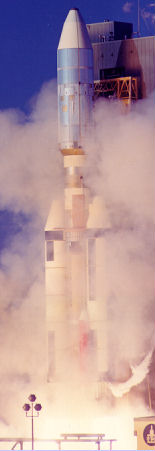TITAN III-E CENTAUR FACT SHEET
By Cliff Lethbridge

Titan III-E Centaur Launch, Photo Courtesy U.S. Air Force
Classification: Space Launch Vehicle
Length: 160 feet, 1 inch
Diameter: 10 feet
Date of First Cape Canaveral Launch: February 11, 1974
Date of Final Cape Canaveral Launch: September 5, 1977
Number of Cape Canaveral Launches: 7
A modified version of the U.S. Air Force Titan III-D, the Titan III-E Centaur was introduced in 1974 to meet the launch requirements for a number of NASA scientific payloads. While the Titan III-D was a two-stage rocket, the Titan III-E Centaur featured the addition of a Centaur D-1T third stage. The Centaur D-1T was powered by two Pratt and Whitney engines which burned liquid oxygen/liquid hydrogen liquid fuel and could produce a combined thrust of 30,000 pounds. Two United Technologies solid rocket boosters burned Powered Aluminum/Ammonium Perchlorate solid fuel and produced a combined thrust of 2,361,000 pounds. The first stage Aerojet dual-chamber first stage engine could produce a 530,000-pound thrust. An Aerojet second stage engine was capable of producing a thrust of 101,000 pounds. The first and second stage engines both burned Aerozine 50/Nitrogen Tetroxide liquid fuel. The overall vehicle was able to carry a 7,400-pound payload to geostationary transfer orbit, an 8,400-pound payload to a Mars or Venus trajectory or a 500 to 1,750-pound payload on a trajectory to the outer planets.


